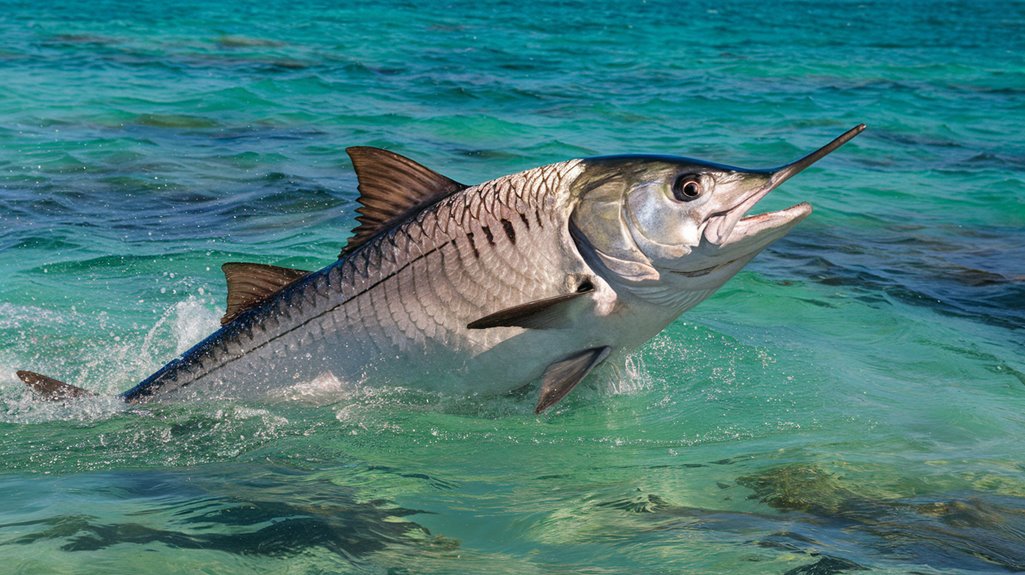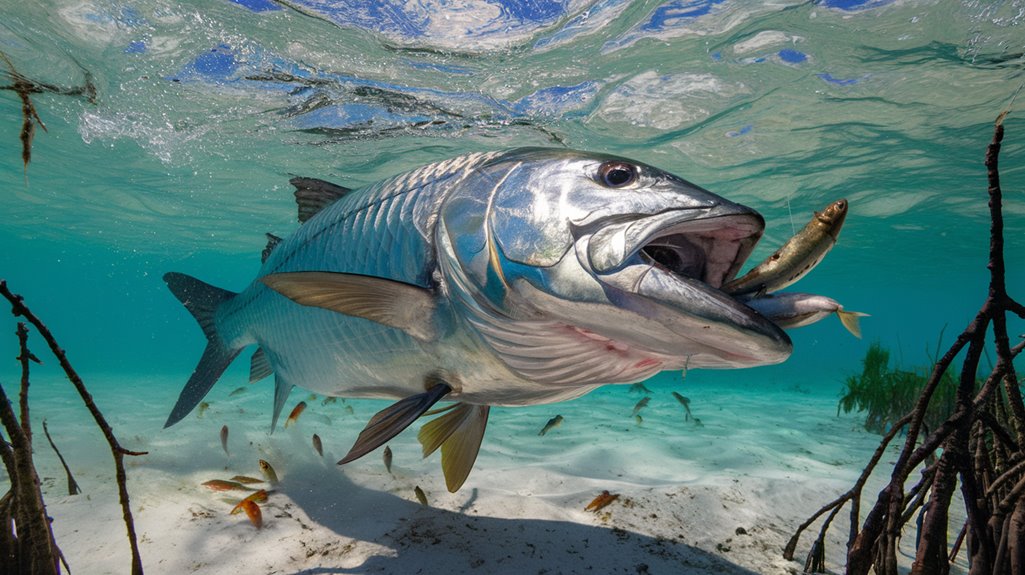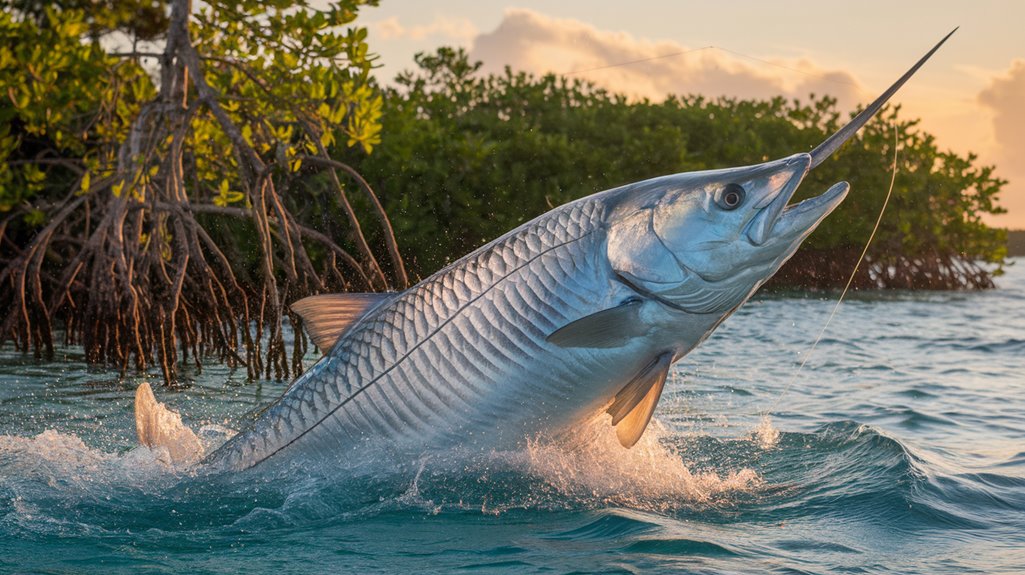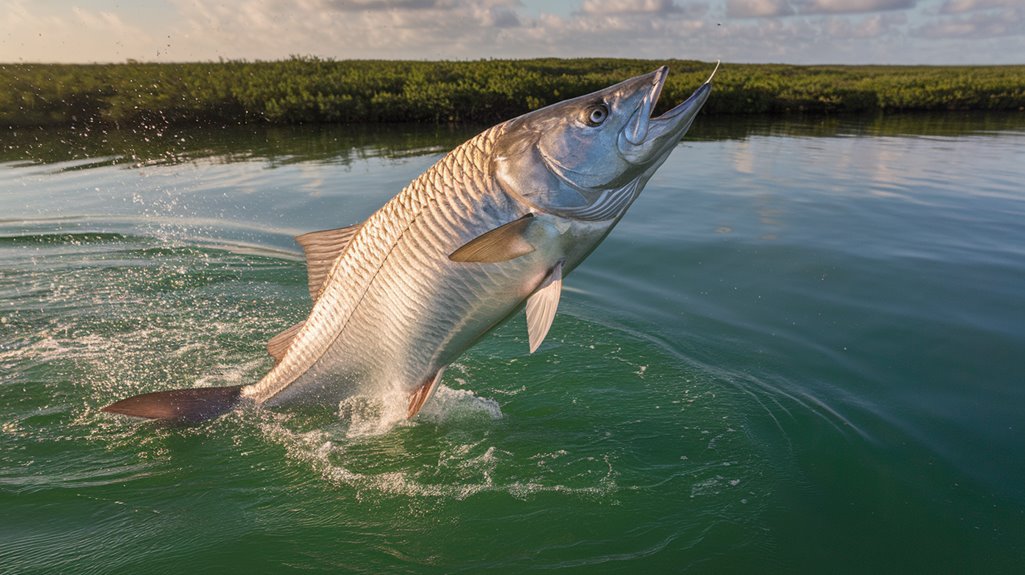You'll discover Florida's Atlantic tarpon stands as one of the most remarkable coastal species, with specimens reaching lengths of 8 feet and weights up to 355 pounds. These ancient fish have adapted to specific habitat requirements, particularly in their juvenile stages where they depend on shallow, protected waters. Their complex life cycle and habitat preferences make them excellent indicators of ecosystem health, and what you'll learn about their behavior patterns could reshape your understanding of marine species management.
- Key Takeaways
- Physical Characteristics and Growth Patterns
- Natural Habitat Distribution
- Feeding Behaviors and Diet
- Migration Routes and Patterns
- Conservation Status and Challenges
- Research Methods and Findings
- Population Dynamics
- Environmental Adaptations
- Angler Partnerships and Citizen Science
- Frequently Asked Questions
- Conclusion
Key Takeaways
- Atlantic tarpon can grow up to 8 feet long and weigh 355 pounds, with lifespans exceeding 50 years.
- Preferred inshore water depths range from 4 to 35 feet, with primary habitats in shallow waters between 1-5 feet.
- Mangrove forests and salt marshes provide critical protection and foraging opportunities for juvenile tarpon development.
- Habitat quality impacts movement patterns, with success linked to proximity to tidal creeks and low-elevation connections.
- Juvenile tarpon select size-dependent prey, primarily feeding on small fishes and crustaceans in coastal nursery areas.
Physical Characteristics and Growth Patterns

A marvel of marine evolution, the Atlantic tarpon exhibits remarkable physical dimensions and growth characteristics that set it apart in coastal ecosystems. You'll find these impressive fish reaching lengths of up to 8 feet and weights of 355 pounds, while sustaining lifespans that can exceed 50 years in ideal conditions.
Growth rates in juvenile tarpon are closely tied to environmental factors within their coastal habitats, where they've developed size-dependent diet patterns. As young tarpon develop, they rely on small fishes and crustaceans as primary prey sources, which directly influences their survival and development. Their body condition fluctuates based on habitat proximity, with environmental stressors considerably impacting their movement patterns. These adaptations demonstrate how Atlantic tarpon optimize their growth potential through strategic habitat selection and feeding behaviors.
Natural Habitat Distribution
You'll find Atlantic tarpon moving along Florida's coastline from shallow estuaries to deeper coastal waters, following seasonal temperature changes and prey availability. These fish typically prefer water depths between 4 and 35 feet in inshore areas, where they can easily access surface air to supplement their oxygen needs. Their movement patterns show a clear preference for protected bays, lagoons, and river mouths, especially during spawning seasons when they congregate in these nutrient-rich environments.
Coastal Range Movement Patterns
The complex movement patterns of Atlantic tarpon span three major coastal regions: the southeastern United States, the Gulf of Mexico, and the Caribbean Sea, extending from Virginia to central Brazil. You'll find these fish undertaking extensive seasonal migrations, traveling thousands of kilometers across international waters between Mexico, Belize, and Nicaragua.
| Region | Primary Habitat | Movement Pattern |
|---|---|---|
| Estuaries | Shallow waters | Daily foraging |
| Mississippi Delta | River discharge zones | Seasonal feeding |
| Mangroves | Protected nurseries | Development stages |
The tarpon's habitat quality directly influences their movement patterns, with juveniles preferring mangrove and salt marsh nursery habitats during their first year. As they mature, they'll shift to deeper coastal waters and estuarine habitats, demonstrating distinct life-stage-dependent migrations that impact recreational fishing opportunities throughout their range.
Inshore Water Depth Preferences
Shallow inshore waters between 1-5 feet deep serve as primary habitats for Atlantic tarpon, particularly in areas connected to mangrove forests and tidal creeks. You'll find these fish thriving in estuaries where environmental factors create ideal conditions for both juvenile and adult populations.
Juvenile tarpon demonstrate a strong preference for mangrove forests, which offer critical protection and foraging opportunities in low-oxygen environments. The success of these habitats depends greatly on their proximity to tidal creeks and low-elevation connections. During warmer months, you'll observe Atlantic tarpon utilizing shallow coastal waters for feeding, while they'll shift to deeper waters as temperatures decline in fall. This habitat flexibility, especially in areas like salt marshes and mangroves, proves essential for their early life stages and long-term survival.
Feeding Behaviors and Diet

While feeding patterns vary throughout their lifecycle, Atlantic tarpon display distinct dietary preferences and behaviors that evolve as they mature. You'll find juvenile tarpon primarily in mangrove and salt marsh habitats, where they feed on small fishes and crustaceans, with copepods being a notable food source. Temperature considerably influences their feeding behavior, with reduced activity observed at both temperature extremes.
Key feeding patterns include:
- Most active feeding at moderate temperatures
- Decreased consumption above 25°C
- Size-dependent prey selection
- Preference for crustaceans in early life stages
- Shift to larger prey items as they grow
Understanding these feeding behaviors is essential for conservation strategies, as habitat preservation directly impacts prey availability and tarpon survival. Current threats from habitat loss necessitate targeted protection of these vital feeding grounds.
Migration Routes and Patterns
Through extensive tracking studies, scientists have documented Atlantic tarpon's remarkable migratory behavior, spanning thousands of kilometers across multiple international waters. You'll find these fish following seasonal patterns, moving northward during spring and summer for foraging activities that typically last four months before their southward return in fall.
The Gulf of Mexico serves as an essential corridor, with tarpon traversing waters near Mexico, Belize, and Nicaragua. A particularly significant critical habitat exists at the Mississippi River Delta, specifically around Pass a Loutre State Wildlife Management Area. For juvenile tarpon, migration timing is closely tied to environmental factors. You'll notice their movement toward open estuaries increases during periods of low barometric pressure and elevated water levels, demonstrating how these Atlantic Ocean wanderers adapt their migration patterns to changing conditions.
Conservation Status and Challenges

Despite their iconic status in Florida's waters, Atlantic tarpon face mounting conservation challenges that have led to their classification as Vulnerable by the IUCN. You'll find their populations increasingly threatened by multiple factors, with habitat degradation and fishing mortality leading the concerns. The loss of critical nursery habitats particularly impacts juvenile development, while recreational fishing release mortality continues to stress adult populations.
Key threats to Atlantic tarpon include:
- Degradation of coastal estuaries and nursery habitats
- Increased recreational fishing mortality rates
- Declining prey availability in traditional feeding grounds
- Directed commercial harvests in several countries
- Compromised water quality in essential habitats
Management strategies must integrate local ecological knowledge and stakeholder engagement to effectively address these challenges and guarantee the species' long-term survival.
Research Methods and Findings
Recent research efforts tracking Atlantic tarpon have yielded substantial data about their movement patterns and habitat preferences. Scientists tagged 23 tarpon with SPOT devices in 2018-2019, employing Kalman filters to guarantee data accuracy. The research revealed critical habitat zones in the northern Gulf of Mexico, particularly around the Mississippi River Delta.
| Research Component | Method Used | Key Finding |
|---|---|---|
| Movement Tracking | SPOT Tags | East-west migration patterns |
| Data Processing | Kalman Filters | Refined position estimates |
| Habitat Analysis | Distribution Study | High utilization of Delta waters |
Your understanding of tarpon behavior has expanded through this research, showing consistent movement patterns in Louisiana waters during fall feeding periods. While spawning wasn't directly observed, larval presence near Pass a Loutre suggests potential breeding grounds in these offshore waters.
Population Dynamics
While Atlantic tarpon exhibit remarkable longevity of up to 50 years, their population faces significant challenges that affect their long-term sustainability. The IUCN's Vulnerable listing reflects critical threats to their population dynamics, stemming from multiple environmental pressures.
Key factors affecting Atlantic tarpon populations include:
- Fishing mortality rates exceeding sustainable levels
- Habitat loss in critical coastal nursery areas
- Degradation of water quality impacting juvenile recruitment
- Overharvesting of essential prey species
- Competition and predation pressures in nursery habitats
Mark-recapture data reveals concerning trends in juvenile growth and survival rates, which you'll find particularly important when considering population resilience. These findings, combined with environmental stressors, suggest that Atlantic tarpon populations require careful management to maintain viable numbers for future generations.
Environmental Adaptations
Through remarkable physiological adaptations, Atlantic tarpon have evolved specialized mechanisms that enable their survival in diverse aquatic environments. You'll find these fish thriving in low-oxygen habitats thanks to their unique ability to gulp air at the surface. Their environmental adaptations begin during the larval stage, where they develop transparent bodies and fang-like teeth.
| Life Stage | Habitat Preference | Key Adaptations |
|---|---|---|
| Larval | Surface waters | Transparent body, fanged teeth |
| Juvenile | Mangroves, marshes | Air-gulping ability |
| Age-0 | Salt marshes | Low oxygen tolerance |
| Sub-adult | Estuaries | Size-dependent feeding |
| Adult | Coastal waters | Diverse habitat usage |
Juvenile tarpon's preference for low dissolved oxygen environments and organic-rich sediments demonstrates their remarkable ability to thrive where other species can't survive. Their feeding patterns evolve with size, focusing on small fish and crustaceans for peak survival.
Angler Partnerships and Citizen Science
You'll find that anglers have become integral partners in tarpon research, with fishing rodeos and clubs contributing nearly 24,000 tissue samples for genetic mark-recapture studies. Through coordinated efforts between scientists and conservation-minded anglers, 23 SPOT tags were deployed on tarpon during 2018-2019, enabling researchers to track migratory patterns across the northern Gulf of Mexico. Your local ecological knowledge as an angler helps bridge critical gaps in stock assessments and shapes effective conservation strategies for Atlantic tarpon populations.
Data Collection Through Anglers
Because citizen scientists and anglers play an essential role in tarpon research, their contributions have generated an impressive dataset of nearly 24,000 tissue samples through genetic mark-recapture studies. The collaborative effort has enabled thorough monitoring of fish movements and population dynamics across the northern Gulf of Mexico.
Key data collection achievements through angler partnerships include:
- Successful tagging and monitoring of 23 tarpon specimens
- Detailed measurements of fork length and girth for each tagged fish
- Precise deployment location documentation
- Integration of satellite telemetry data
- Extensive habitat mapping through movement tracking
This conservation-focused partnership with anglers has filled critical knowledge gaps in tarpon population structure, enabling more informed management strategies. The data collection process combines traditional angling expertise with scientific methodology, creating a robust framework for understanding tarpon behavior and habitat preferences.
Building Conservation Partnerships
The successful conservation of Atlantic tarpon hinges on robust partnerships between scientists and anglers, evidenced by the collection of 24,000 tissue samples and tracking of over 300 tagged specimens. These conservation partnerships integrate local ecological knowledge with scientific research, strengthening fisheries management strategies.
You'll find recreational fishing communities playing a crucial role through organized tagging programs and data collection efforts. The Bonefish and Tarpon Trust's initiatives demonstrate how angler participation enhances understanding of nursery habitats and juvenile tarpon distribution. Through systematic monitoring and reporting, you're contributing to a thorough database that informs habitat quality assessments and sustainable fishing practices.
This collaborative approach guarantees that conservation efforts reflect both scientific priorities and stakeholder insights, creating more effective strategies for Atlantic tarpon preservation.
Frequently Asked Questions
What's so Special About Tarpon?
You'll find tarpon extraordinary for their massive size up to 8 feet, ability to breathe air, remarkable 50+ year lifespan, and their fighting strength that's made them legendary among game fish.
How Big Do Florida Tarpon Get?
You'll find Florida tarpon growing up to 8 feet in length and reaching weights of 280 pounds, though some exceptional specimens can grow even larger. They're among Florida's largest coastal game fish.
What Is the Habitat of Tarpon?
You'll find tarpon in shallow coastal waters, estuaries, and mangrove areas. They're adaptable, inhabiting environments from tidal creeks to open marine waters, and can even survive in freshwater lakes and rivers.
How Big Are Atlantic Tarpon?
You'll find Atlantic tarpon reaching impressive dimensions: up to 8 feet in length and 355 pounds in weight. They start tiny as transparent larvae but grow considerably throughout their 50+ year lifespan.
Conclusion
You'll find that Florida's Atlantic tarpon populations demonstrate complex ecological relationships, requiring specific habitat conditions for successful development. Data shows juvenile survival rates correlate directly with mangrove density and water depth parameters of 1-5 feet. Your research participation through catch-and-release data collection continues to enhance our understanding of their migration patterns, growth rates, and population dynamics within coastal ecosystems.

